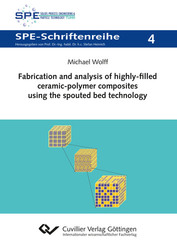| Areas | |
|---|---|
| Serie de libros (96) |
1378
|
| Nachhaltigkeit |
3
|
| Gesundheitswesen |
1
|
| Letra |
2365
|
| Ciencias Naturales |
5406
|
| Ciencias Ingeniería |
1793
|
| Ingeniería | 292 |
| Ingeniería mecánica y de proceso | 862 |
| Ingeniería eléctrica | 686 |
| Mineria y metalurgía | 30 |
| Arquitectura e ingeniería civil | 75 |
| General |
98
|
|
Leitlinien Unfallchirurgie
5. Auflage bestellen |
|
Erweiterte Suche
Fabrication and analysis of highly-filled ceramic-polymer composites using the spouted bed technology (Volumen 4) (Tienda española)
Michael Wolff (Autor)Previo
Indice, PDF (120 KB)
Lectura de prueba, PDF (640 KB)
In this thesis a versatile process route for the fabrication of novel bulk composite materials is developed, which is based on the spouted bed spray granulation process. The granulation process is used to assemble different kinds and sizes of ceramic particles and polymers into granules. In this process a liquid, which contains organic (and sometimes inorganic) components, is sprayed onto fluidized particles. The key advantages of the spouted bed spray granulation process are analyzed with respect to the fabrication of novel composite materials, and several process routes for different types of polymers and different target properties are developed. The granules are further processed to dense composites, which are then analyzed with respect to their morphology and mechanical properties. It is also shown that this process route can be combined with other processes to fabricate composites with a genuine hierarchical structure. The inner structure and the mechanical properties of the final composites are analyzed and simulated with the Discrete-Element-Method (DEM). It is shown that the DEM is a very useful and adequate simulation tool for the fabricated composites, particularly for composites with a high filling degree, as it allows a direct three-dimensional representation of the composite.
| ISBN-13 (Impresion) | 9783736991378 |
| ISBN-13 (E-Book) | 9783736981379 |
| Formato | B5 |
| Idioma | Inglés |
| Numero de paginas | 184 |
| Edicion | 1. Aufl. |
| Serie | SPE-Schriftenreihe |
| Volumen | 4 |
| Lugar de publicacion | Göttingen |
| Lugar de la disertacion | Hamburh-Harburg |
| Fecha de publicacion | 12.11.2015 |
| Clasificacion simple | Tesis doctoral |
| Area |
Ingeniería mecánica y de proceso
|
| Palabras claves | spouted bed, granulation, composites, DEM |








